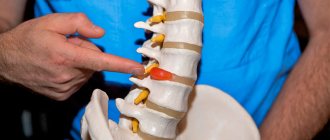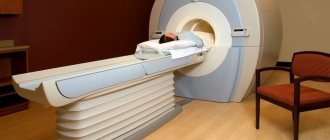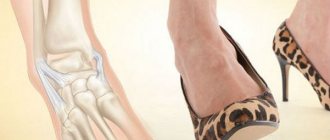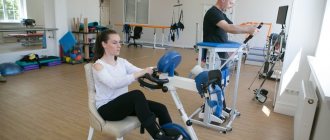There can be many reasons why a patient has numbness in the lower leg. Doctors divide them into two logical blocks: random and caused by pathologies. The first includes an uncomfortable posture, low physical mobility, prolonged hypothermia, and narrow, uncomfortable shoes. Here you just need to remove the source of discomfort. If conditions where the lower part of the leg goes numb recur regularly, it is necessary to conduct a diagnosis and find the original source of the problem. In many ways, the location of the unpleasant sensations helps with this.
Thigh numbness
Most often, loss of sensation in the lower extremities is a consequence of problems with the spine. The prerequisites for this are:
- radicular pinching;
- vertebral displacement;
- tunnel syndrome (compression of nerve fibers);
- intervertebral hernia;
- disc protrusion.
Other possible sources of symptoms:
- inflammation of the sciatic nerve;
- high loads on the ankle;
- post-traumatic syndrome;
- problems with the femoral head.
Why does my leg go numb?
Physiological reasons
Short-term numbness of the leg occurs when the blood vessels are compressed against the background of an uncomfortable position of the limb. In representatives of professions associated with prolonged standing and walking, slight numbness of the feet and legs appears towards the end of the day, due to overwork. The symptom is combined with pain, heaviness, and distension. It is detected among hairdressers, salespeople, and waiters.
Neuropathies
In patients with mononeuropathies, one limb is involved in the pathological process. The localization and extent of the zone of numbness in neuropathy are determined by the affected nerve trunk:
- Sciatic nerve.
The posterior surface of the lower leg and some areas of the foot become numb. Sciatica is detected. - Femoral nerve.
The numbness zone covers the lower 2/3 of the front surface of the thigh, the entire anterior inner surface of the lower leg. - Tibial nerve.
Sensitivity is impaired along the entire posterior surface of the leg, in the lower third of the segment it spreads laterally. - Peroneal nerve.
The lateral surface of the lower leg suffers. - External cutaneous nerve of the thigh
. Numbness occurs along the outer side of the thigh, then spreads to the front surface.
Extensive sensory disturbances are detected in patients with lumbar and sacral plexitis. The area of numbness may vary depending on the predominant damage to certain nerves. When disorders predominate at the lumbar level, hypoesthesia is detected mainly along the anterior surface of the leg, at the level of the sacrum - along the posterior surface.
Polyneuropathy
In polyneuropathies, decreased sensitivity is often preceded by paresthesia and hyperesthesia. Numbness covers both legs in a “sock-like” manner and gradually spreads proximally. Combined with muscle atrophy and gait changes. Common variants of the disease are alcoholic and inflammatory polyneuropathies (including CIDP), neuropathy of pregnancy.
People with insufficient functions of internal organs develop metabolic neuropathies. Pathology is detected in cases of damage to the liver, kidneys, and severe diabetes mellitus. In addition, multiple nerve damage occurs in systemic vasculitis, neuroAIDS, neuroacanthocytosis, and other diseases.
Numbness of the leg
Dorsopathies
Lumbar dorsopathies are a heterogeneous group of diseases of the spine and surrounding tissues, accompanied by numbness, weakness in the legs, cramps, constant or periodic pain in the lower back, radiating to the lower limb. Hypoesthesia is caused by radicular syndrome, myelopathy. Observed in the following cases:
- Degenerative lesions
: osteochondrosis, disc protrusion, intervertebral hernia, Schmorl's hernia. - Spinal deformities
: kyphosis, lordosis, scoliosis. - Spondylopathies
: spondylosis, spinal stenosis, spondylitis, tuberculosis, osteomyelitis, neuropathic, traumatic spondylopathies.
Restless legs syndrome
The pathology is accompanied by numbness, itching, paresthesia, and attacks of involuntary motor activity. Symptoms decrease or disappear with movement, intensify at rest, especially at night. Both legs are involved, and asymmetrical lesions are less common. Numbness first occurs in the lower legs. Subsequently, hypoesthesia and other discomfort spread to the feet and hips.
Other nervous diseases
Damage to the pathways or corresponding centers in the brain leads to numbness in one or both legs. The symptom is detected in diseases such as:
- Cerebral circulation disorders.
One arm and one leg are affected. In a transient form of the pathology, hypoesthesia persists for several minutes or hours, then disappears without a trace. With a stroke, numbness is permanent. - Disorders of the spinal circulation
. In the chronic form (myelogenous intermittent claudication), numbness and weakness of the legs occur in attacks and disappear after rest. Spinal stroke is accompanied by rapidly increasing symptoms. Along with numbness, paresis or paralysis and dysfunction of the pelvic organs are detected. - Multiple sclerosis.
The clinical picture is polymorphic. Numbness, paresthesia, muscle weakness can be detected in the upper and/or lower extremities. Subsequently, spastic paresis, ataxia, and hyperkinesis develop.
Traumatic injuries
The most serious cause of numbness in the legs is spinal cord injury. Hypesthesia or complete loss of sensitivity is combined with paresis and paralysis. The cause of the violation of the integrity of the peripheral nerve is injury to the area of the buttock, thigh, and lower leg. Damage from bone fragments during fractures is rare. The zone of numbness coincides with that of mononeuropathy of the corresponding nerve.
With positional compression syndrome, a rapid increase in edema, and some other conditions, myofascial compartment syndrome may develop, accompanied by intense pain and subsequent numbness of the leg distal to the site of injury. The cause of numbness after applying a cast is an increase in swelling. To prevent complications, cutting of the bandage is required.
Vascular diseases
In obliterating diseases of the peripheral arteries (endarteritis, thromboangiitis, peripheral atherosclerosis), Mönckeberg arteriosclerosis, numbness is localized mainly in the feet. Atherosclerosis of the abdominal aortic bifurcation is characterized by widespread hypoesthesia of the legs, swelling of the feet, and trophic disorders.
Acute occlusion of the arteries due to obliterating pathologies and some other diseases of the cardiovascular system is manifested by sudden numbness, pain, paresis, and in the absence of treatment - necrosis of the distal parts of the limb. Pain, cramps, numbness in the legs at night are detected with subcompensated and decompensated varicose veins and occur against the background of chronic venous insufficiency.
Other reasons
Temporary or permanent numbness of the legs can be observed with the following pathologies:
- Hypovitaminosis
: beriberi, pellagra, hypovitaminosis B12. - ODS diseases
: osteitis deformans. - Cardiovascular pathologies
: vegetative-vascular dystonia. - Emergency conditions
: solvent poisoning. - Parasitoses
: filariasis. - Mental disorders
: senestopathies, hysterical neurosis.
Ultrasound of blood vessels of the lower extremities
Numbness in the calves as a result of a lack of microelements
If your leg goes numb from the knee down at night, while doing physical exercises or walking, you can assume a lack of microelements:
- calcium (accompanied by mild cramps);
- potassium (leads to heart rhythm disturbances and high blood pressure);
- magnesium (combined with increased irritability, nervousness);
- B vitamins (manifested by weakening of memory, attention, imbalance in the functioning of the central nervous system).
How does numbness in the leg manifest?
Most often, patients experience numbness on the inside or side of the leg, in the calf muscle. Along with this, the following symptoms may appear:
Advertising:
- the lower part of the leg itches, pricks, aches;
- the skin becomes dry and its color may change;
- “goosebumps” periodically tingle in the lower legs;
- pain appears in the lumbar region, in the buttocks area;
- the affected leg freezes more often, the skin on the lower leg becomes a little colder;
- Stiffness in the ankle joint becomes more frequent, discomfort increases when bending over.
Numbness in the right and left leg
It matters which limb the numbness is felt in:
- If the right leg is numb, most likely there is neuropathy of the right sciatic nerve, caused by osteochondrosis or a hernia. With timely treatment, it is not difficult to get rid of the disease;
- You should be wary of situations where a decrease in sensitivity is observed in the left leg, but there are no other painful sensations. This condition may be a prerequisite for a stroke, mini-stroke or transit ischemic attack. Ignoring numbness in this case will only make the situation worse;
- In rare cases, the patient experiences numbness in both legs at the same time - this is a sign of a serious spinal disease. In the initial stages, sensitivity decreases only periodically, but as the disease progresses, the phenomenon can become permanent.
In order to correctly diagnose the disease that caused the numbness, the patient needs to undergo a full examination, in particular, an ultrasound and MRI of the spinal column and lumbar region.
What to do if your left or right leg goes numb from the knee to the foot
Usually, temporary numbness can be quickly relieved using simple methods. If your legs go numb due to a neurological or vascular disease, these methods are not enough. It is necessary to undergo examinations to find the cause. Only after this is treatment prescribed.
General recommendations
If your legs go numb infrequently, you can get by with general recommendations. What is recommended to do to get rid of the symptom:
- Change your position, get up from your chair and walk. This will improve blood circulation in the lower leg.
- Choose comfortable shoes. It is better to choose shoes in the afternoon, as at this time the feet swell more.
- Make a foot bath. You can use folk remedies - chamomile, parsley, mint, sea salt. After a warm bath, you can wipe the skin of your feet with an ice cube.
- Massage your feet and legs.
- Stretching, doing yoga.
These are effective recommendations that will help get rid of numbness if it is not associated with any disease. If the cause is a disease of the nerves or blood vessels, following these recommendations is not enough.
Calf massage can help with numbness
Survey
An examination for numbness of the extremities is prescribed by a doctor. Both laboratory and instrumental studies may be prescribed.
| Research method | Explanation |
| X-ray of the lumbar spine | Plain radiography is prescribed to identify gross changes in the spine. This is an accessible, but not specific research method. It only allows one to suspect pathology; to further clarify the diagnosis, more specific studies are used - MRI, CT scan of the spine. |
| Magnetic resonance imaging of the spine | Helps determine the presence and location of an intervertebral hernia. |
| Dopplerography of the vessels of the extremities | Prescribed to assess the state of blood flow in the lower extremities. |
| Blood chemistry | If there is numbness in the legs, tests are prescribed: · lipidogram (total cholesterol, high and low density lipoproteins, triglycerides) – to determine dyslipidemia; · blood glucose level – for diagnosing diabetes mellitus. |
Drug treatment
Numbness should be treated taking into account the cause that caused its appearance. Treatment is selected by the doctor after a comprehensive examination and identification of the underlying disease. Symptomatic treatment is not used.
| Disease | Treatment methods |
| Osteochondrosis | Complex treatment: 1. Medications. Anti-inflammatory drugs, painkillers and B vitamins are used. 2. Therapeutic gymnastics. The exercises are aimed at strengthening the muscle corset. 3. Fixation of the spine. To reduce the load on the spine, it is recommended to wear a special belt. 4. Massage. Massage helps relieve muscle tension and reduce pain. The duration of treatment is from 1 to 3 months. |
| Intervertebral hernia | The main method of treating intervertebral hernia is surgery. In addition to surgery, traction therapy (traction) can be used. |
| Atherosclerosis | To treat atherosclerosis, conservative therapy or surgical treatment is used. Conservative therapy includes the following methods: 1. Following a diet that includes a sufficient amount of polyunsaturated fatty acids, vegetables and fruits. 2. Regular physical activity. 3. Stop smoking and drinking alcohol. 4. Medications aimed at normalizing the lipid spectrum. The most commonly used statins are Atorvastatin, Rosuvastatin. Surgical treatment is aimed at restoring blood flow (bypass surgery). |
| Diabetic polyneuropathy | Treatment is aimed at normalizing carbohydrate metabolism and preventing complications. Most often, insulin therapy and dietary nutrition are prescribed, and less commonly, oral glucose-lowering drugs. It is also recommended to select orthopedic shoes and undergo regular examinations by a neurologist. Additionally, polyunsaturated fatty acids and B vitamins are used. |
| Varicose veins | Treatment can be medicinal or surgical, the choice of method depends on the stage of the disease. Drug treatment consists of the use of venotonics. Additionally, drugs are used to prevent complications - antiplatelet agents, anticoagulants. |
What does the symptom mean?
Numbness (paresthesia) is a form of sensory impairment. Paresthesia is characterized by the following symptoms:
- tingling;
- crawling;
- numbness;
- burning of the skin.
Such sensations can occur in any part of the body. In most cases, they indicate a violation of sensory innervation. Less commonly, it may cause circulatory problems in the affected area. That is, if there is numbness, you should look for pathology of the nervous tissue, veins or arteries.
Two nerves are responsible for the sensitive innervation of the lower leg:
- Tibial nerve - provides sensation to the back of the leg.
- Common peroneal nerve - provides sensation to the anterior and outer surface of the leg.
These nerves are paired. When one nerve is affected, symptoms occur on only one side - the right or left leg goes numb from the knee to the foot. But bilateral damage is more common.










